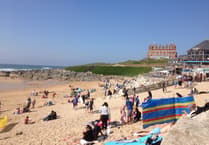I WAS battling up the hill to King Arthur’s Hall on Bodmin Moor, fighting a pretty fresh wind from the north. Wind is something we are pretty familiar with in Cornwall but I was reflecting as I climbed on why we have wind and what creates it.
Our atmosphere on Earth is in a natural circulation created by the difference in heat between the polar and equatorial regions, together with the Coriolis Effect, caused by our planet spinning on its axis.
So, essentially, differences in the air temperature, caused by differential heating by land and sea, create different atmospheric pressures around the world.
If you look at the weather forecasts on the television, you’ll see high pressures and low pressures depicted on the maps. Nature tries to equalise these out and air tries to move from one or the other.
The intensity of the pressure systems defines how strongly the air moves from one to the other. Hence, a “deep low” will entail the high winds and rains we see so often battering our coasts in Cornwall.
The Coriolis Effect means storms have air moving clockwise in the northern hemisphere and anti-clockwise in the southern hemisphere.
This also means the air movement from the tropics to the poles in the northern hemisphere is deflected to the right, resulting in our wind blowing mainly from the south west.
This explains why American hurricanes, which lose energy as they cross the Atlantic, finish up on our side of the ocean as storms.
At least this process gives us a mild, if somewhat damp, climate.
• Fred Knobbit is a nature blogger. He grew up in the Pennines in Lancashire on the edge of an industrial town but is now safely in Cornwall. You can read his archive at www.bodminblogger.com





Comments
This article has no comments yet. Be the first to leave a comment.